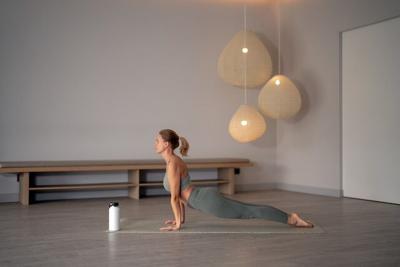
Stretching is an important component of any fitness routine, as it helps to increase flexibility and range of motion while reducing the risk of injury. But not all stretching exercises are created equal—different types of stretches work for different muscle groups and have varying intensity levels. Therefore, to maximize your workout, it's important to understand the various stretching types recommended by fitness experts.
This article will discuss the five most common forms: dynamic stretching, static stretching, active isolated stretching (AIS), ballistic stretching, and proprioceptive neuromuscular facilitation (PNF). Understanding each type and its benefits allows you to choose the best form for your needs.
Dynamic Stretching
Dynamic stretching is an important part of any physical activity routine, as it helps to revive and re-energize the body. This form of stretching involves slowly moving your body through a full range of motion, which helps improve flexibility and strength. In addition, it is considered more efficient than static stretching because it improves movements in the muscle joints, preparing them for more strenuous activities.
With dynamic stretches, you can warm up the muscles efficiently before engaging in physical activity or competition, reducing the risk of potential injuries and allowing maximum performance potential. These exercises also act as an active recovery technique following strenuous sessions.
As such, it is beneficial to incorporate dynamic stretching into any exercise regime to gain optimal performance results while staying safe throughout your exercise journey.
Static Stretching
Static stretching is a great way to improve flexibility, range of motion, and overall mobility. Through static tricep stretches, for example, you can reduce muscle tension and increase joint range of motion. However, completing the stretches correctly is important, as an incorrect technique or overstretching can do more harm than good.
With patience and persistence, you can successfully use static stretching as part of your fitness routine and enjoy the improved feeling of flexibility that comes with it.
Active Isolated Stretching (AIS)
Active Isolated Stretching (AIS) is an effective, dynamic form of muscle stretching developed by Aaron Mattes in the 1990s. It differs from traditional forms of stretching in that it targets individual muscles or muscle groups with multiple repetitions of quick and precise stretches. By taking this approach, AIS helps to improve the range of motion, balance, posture, and circulation without compromising the body's natural ability to repair itself.
Additionally, as a form of therapeutic exercise, AIS is designed to prevent injuries while facilitating rehabilitation - restoring mobility and reclaiming lost muscle function. Therefore, AIS is a tremendous asset to competitive athletes and those seeking general fitness maintenance.
Ballistic Stretching
Ballistic stretching is a technique most often used by competitive athletes and serious gym-goers. It is a type of dynamic stretching that involves using momentum and the body's response to it to achieve a greater range of motion in the muscles. The movements require quickness, force, and control to extend beyond the typical range.
Without proper form and training, ballistic stretching can be unsafe and may cause further injury - this is why it's important to train under an experienced coach or practitioner before going it alone. Even though there are some risks, Ballistic stretching has many benefits, such as improved relaxation, flexibility, coordination, and overall strength when performed properly.
Proprioceptive Neuromuscular Facilitation (PNF)
Proprioceptive Neuromuscular Facilitation (PNF) is an advanced form of physiotherapy that helps to improve muscle strength, range of motion, and coordination. Developed in the 1940s, PNF relies on specific exercises involving both passive and active movement and resistive stretching designed to create multi-directional reflex responses from joints and muscles.
By engaging the proprioceptive system to promote improved neurological control, PNF techniques are highly effective at creating changes in muscular strength and joint range of motion. As a result, this therapy is more efficient and longer lasting than many traditional physical therapy methods when helping people recover from injuries or regain movement after periods of stagnation.
Choosing the Best Form for Your Needs
Ultimately, the best form of stretching for you depends on your individual goals and fitness level. For example, some may prefer dynamic stretching to warm up the body before physical activity, while others may find static stretching more beneficial in improving flexibility and range of motion.
To maximize the results of any stretching technique, remember that safety should always be a priority. Make sure to control your movements and never force yourself beyond what you're comfortable with. As long as you practice patience and follow the proper techniques, stretching can improve strength, flexibility, and overall physical health.
Conclusion
Stretching is essential to any physical fitness routine, from novice to professional athletes. With various stretching techniques available, such as static stretching, active isolated stretching, ballistic stretching, and proprioceptive neuromuscular facilitation (PNF) technique - each with specific benefits and risks - it's important to choose the right form of stretching for your individual needs. Also, remember to listen to your body and take all safety precautions when stretching; you'll have the best chance of reaping the benefits.
Here are Some Other Articles Related to Your Search:



(0) comments
We welcome your comments
Log In
Post a comment as Guest
Keep it Clean. Please avoid obscene, vulgar, lewd, racist or sexually-oriented language.
PLEASE TURN OFF YOUR CAPS LOCK.
Don't Threaten. Threats of harming another person will not be tolerated.
Be Truthful. Don't knowingly lie about anyone or anything.
Be Nice. No racism, sexism or any sort of -ism that is degrading to another person.
Be Proactive. Use the 'Report' link on each comment to let us know of abusive posts.
Share with Us. We'd love to hear eyewitness accounts, the history behind an article.